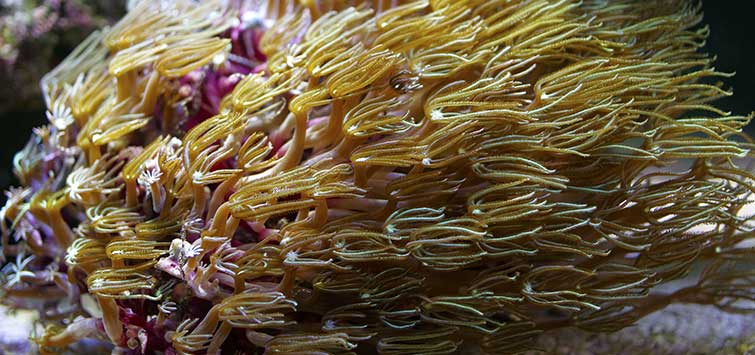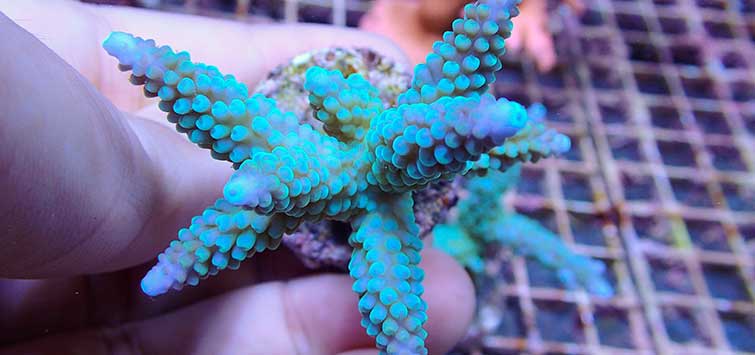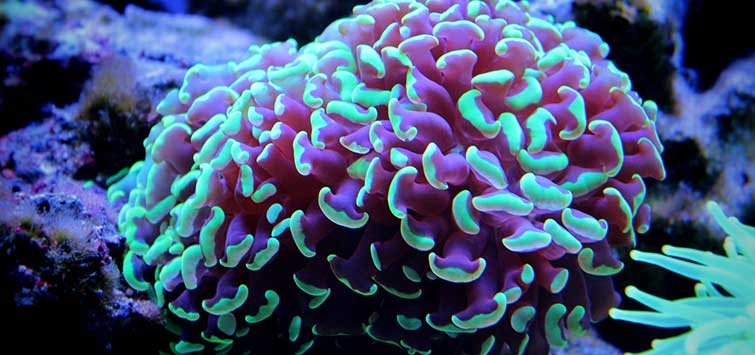The Reefer: Two Unique Stony Corals: The Blue Coral and the Pipe Organ Coral
Author: James W. Fatherree, MSc
“True” skeleton-building corals belong to a single biological group known as the class Anthozoa and the subclass Hexacorallia. They make a hard skeleton composed of calcium carbonate, and they also bear tentacles that come in some multiple of six. Even when living in colonies, as most do, each of the little polyps that make up a colony has a multiple of six tentacles, as well.
However, this month we’ll take a look at a couple of their cousins that also make a hard skeleton, but don’t fit in with the rest of the true stony corals, as they have polyps that bear eight tentacles and some other features that set them apart. These are the blue coral and the pipe organ coral, both members of the anthozoan subclass Octocorallia that are offered from time to time in the aquarium hobby.
The Blue Coral
The blue coral Heliopora coerulea is an octocorallian, and as mentioned, each of the polyps that make up a blue coral colony has eight tentacles rather than six. It’s a member of the octocorallian order Helioporacea, which contains only a few species, and many of these are deep-living non-reef-building corals. H. coerulea, however, which is the species you’ll find at a shop, is a reef-dwelling species that lives in shallow waters.
Polyps
Unlike the true stony corals, the blue coral has very thin, small polyps that look more like hairs than the regular polyps we’re used to seeing on stony corals. In fact, they really look more like those of the fire coral Millepora sp., if you happen to know what those look like. The blue coral’s polyps are also connected together by thin strands of flesh that run throughout the skeleton under its surface, and they emerge from small pinhole-like pores that cover it. By contrast, the polyps of regular colonial stony corals are connected by tissue that covers the surface of their skeletons, rather than running through them.
Why Blue?
So why is it called the “blue” coral? Because the skeleton is blue, rather than the living flesh. True stony corals produce a white calcium carbonate skeleton, but blue corals have a unique pigment in their skeletons that gives them a deep blue color. For this reason, blue coral skeletons are often seen sold as decorations in shell/curio shops. When they’re alive they actually look greenish to brown, though.
Tank Conditions
When it comes to keeping them in aquariums, they’re typically as hardy as any other coral can be, as long as they have plenty of light and are bathed in a relatively strong current. This coral is usually found in relatively shallow water, and thus should be given as much light as possible when placed in a tank. The currents in the areas where they live are typically strong and turbulent. So, again, you should try to recreate such conditions in a tank.
Water Quality
Water quality should be excellent, as always when we’re dealing with corals. And since they do build a calcium carbonate skeleton, you should try to maintain a calcium concentration in the range of 380 to 450 ppm (the higher the better), with an alkalinity in the range of 7 to 12 dKH (again, the higher the better), in order to ensure that they can continue to grow normally.
Temperature Notes
There is one interesting note that I came across while doing some extra homework about this coral. Fossa and Nilsen (1998) noted that the blue coral prefers relatively high temperatures, and won’t live below 72°F. That won’t be a problem for most reef aquarists, but it’s still warmer than the minimum temperature of many other stony corals. Additionally, Borneman (2001) noted that they prefer an optimal temperature of about 84°F. While the standard recommendation was about 75°F many years ago, that has changed, and now it’s accepted that tanks can be run in the low to mid 80s without problems (as long as the air conditioner doesn’t die in the summer). Thus, temperature shouldn’t be an issue.
The Pipe Organ Coral
The pipe organ coral Tubipora spp., which is also often called the organ pipe coral, is another oddity because it’s a member of the octocorallian order Alcyonacea, and more specifically the suborder Stolonifera. Star polyps and clove polyps are the typically stoloniferans, neither of which builds a skeleton, meaning the pipe organ coral’s closest cousins are soft bodied.
The “Pipes”
Strangely, specimens build a hard skeleton that’s composed of numerous hollow tubes. These tubes are indeed made of calcium carbonate, but like the blue coral, they also add in pigments that give their skeleton a strong color—in the case of the pipe organ coral, the pigments produce a deep red color instead of blue. Colonies of pipe organ coral typically consist of rounded, massive skeletons that are always attached to hard substrates, and these tubes that make up a colony are all joined laterally by numerous thin, horizontal skeletal layers that fuse them all together.
Polyps
And that’s not all, either. On top of having a very unusual skeleton, the eight-tentacled polyps of many pipe organ corals are indistinguishable from those of a colony of clove polyps or star polyps (at least to a hobbyist). They also emerge from the ends of the tubes, and they’re connected together below the top surface of the skeleton by strands of flesh called stolons. They can have a few different looks to them as well.
While many do look pretty much just like clove polyps or star polyps, an occasional specimen may have quite distinct polyps that look like tiny eight-pointed stars. Regardless, they’re likely all one of only two species according to Veron (2000), one of which hasn’t been given a species name. For the longest time I’d thought there was only one species, Tubipora musica, but apparently there’s the unnamed one and possibly others, too. Anyway, the polyps can also vary in color, most often being light green, gray, or almost white in color, and usually the tentacles of each polyp are lined with tiny branches, called pinnae.
Aquarium Conditions
As far as aquarium conditions go, the pipe organ coral also prefers intense lighting and a moderate to strong current. Do note that their polyps are much larger than those of the blue coral, and if currents are actually too strong, the polyps will stay retracted in the skeletal tubes. Still, what you must ensure is that the current is always strong enough to keep detritus from settling and collecting on the skeleton in the gaps between the polyps. Everything else should be “normal,” and you can follow the same suggestions I made above with respect to calcium and alkalinity.
Hardiness
When it comes to hardiness, things get a little contradictory, unfortunately. On one hand, several sources say that the pipe organ coral is hardy, but more than a few hobbyists have reported exactly the opposite, even when everything else is doing fine. In such situations, I can only guess that a lot of it has to do with getting a good specimen in the first place, and that can be difficult to judge sometimes. Pipe organ corals can fully retract their polyps into the tubes and typically do so when they are collected and shipped. The polyps may stay retracted for many, many days even after they are held at a shop or placed in a tank. So it can be hard to judge the overall apparent health of a specimen unless you’re very patient.
In addition, smaller specimens are often cut away from larger colonies, which damages/kills at least a few of the polyps around their borders and leaves the skeletal tubes open on their bottom ends. And many complete colonies are also cut away from whatever substrate they are attached to, which also leaves the tubes open at the bottom.
Survival
So, to throw in a piece of purely anecdotal information, I’ve also been told that survival often depends on the condition of the bottom of a collected colony. As the story goes, if many or all of the skeletal tubes are open on their bottom ends, this could allow any sort of sediments, microbes, and anything else to enter the bottom end of the tubes and negatively affect the polyps residing in them. So an open-ended colony would be more likely to have problems and possibly die (or at least experience the die-off of many polyps).
On the other hand, if a colony is left attached to a substrate, the tubes stay sealed, and such problems are less likely to occur. This should make attached colonies much more desirable to shoppers, although I wonder if a colony with numerous broken tubes could be washed thoroughly and then epoxied/glued to a piece of live rock or shell to artificially seal the tubes. While I don’t have enough personal experience with this type of coral to verify this, it does seem to make sense and could offer an explanation for why some people have reported them to be hardy, while other hobbyists have reported that they aren’t.
As a last note, Lewis (1982) also reported that pipe organ corals capture fine particulate matter and zooplankton with their tentacles. So, assuming they do capture particulate foods and prey, they may also benefit from the addition of specialty invertebrate foods and/or being placed in an aquarium that uses a deep sand bed or refugium to provide a natural food source for its inhabitants.
References
Borneman, E. H. 2001. Aquarium Corals: Selection, Husbandry, and Natural History. TFH/Microcosm Professional Series, Neptune City, NJ. pp. 114, 121–123.
Fossa, S. and A. Nilsen. 1998. The Modern Coral Reef Aquarium, Volume 2. Birgit Schmettkamp Velag, Bornheim, Germany. 226–228.
Lewis, J. B. 1982. “Feeding behaviour and feeding ecology of the Octocorallia (Coelenterata: Anthozoa).” Journal of Zoology. 196(3):371–384.
Rupert, E. E., R. S. Fox, and R. D. Barnes. 2004. Invertebrate Zoology: A Functional Evolutionary Approach: 7th ed. Brooks/Cole, Thomson. Belmont, CA. pp. 139–143.
Veron, J. E. N. 2000. Corals of the World. Australian Institute of Marine Science, Townsville, Australia. v.3, pp. 406–407.

.png?h=595&iar=0&w=2781&hash=5FD5E69473BCC22199FBFA2FB71B6033)



